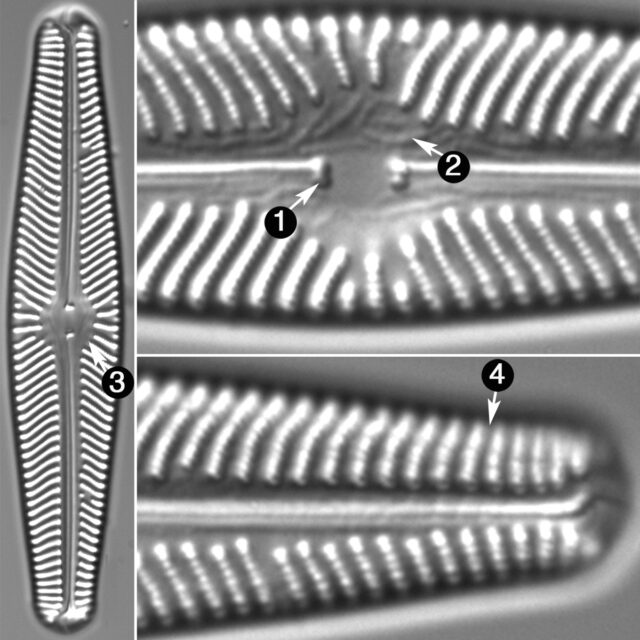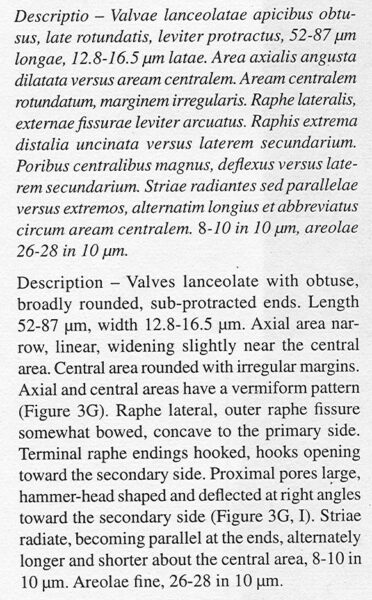Navicula sovereignii
-
Category
-
Length Range52-87 µm
-
Width Range12.8-16.5 µm
-
Striae in 10 µm8-10
-
Reported AsNavicula aurora (Bahls 2005)
-
ContributorLoren Bahls - Nov 2011
-
ReviewerSarah Spaulding - Jan 2012
Identification
Description
Valves are lanceolate with obtuse, broadly rounded, sub-protracted ends. The axial area is narrow, linear, widening slightly near the central area. The central area is rounded with irregular margins. Axial and central areas have vermiform markings. Raphe branches are lateral and outer raphe fissures are somewhat bowed, concave to the primary side. Proximal raphe ends are bulbous and laterally expanded, the larger part on the secondary side of the valve. Striae are radiate, becoming parallel at the ends and alternately longer and shorter about the central area. Areolae are fine and number 26-28 in 10 µm.
Autecology
Besides the type locality in eastern Oregon, there are three records of Navicula sovereignii in the Montana Diatom Collection from streams in the Cascade Mountains of western Oregon, where pH is circumneutral (range = 6.7-7.6) and conductance is very low (range = 27-53 µS/cm).
-
Size Range, µm3
-
Motility
-
Attachment
-
Habitat
-
Colony
-
Occurrence
-
Waterbody
- Learn more about this
Original Description
Valves lanceolate with obtuse, broadly rounded, sub-protracted ends. Length 52-87 μm, width 12.8-16.5 μm. Axial area narrow, linear, widening slightly near the central area. Central area rounded with irregular margins. Axial and central areas have a vermiform pattern. Raphe lateral, outer raphe fissure somewhat bowed, concave to the primary side. Terminal raphe endings hooked, hooks opening toward the secondary side. Proximal pores large, hammer-head shaped and deflected at right angles toward the secondary side. Striae radiate, becoming parallel at the ends, alternately longer and shorter about the central area, 8-10 in 10 μm. Areolae fine, 26-28 in 10 μm.
-
AuthorBahls 2011
-
Length Range52-87 µm
-
Width12.8-16.5 µm
-
Striae in 10µm8-10
Citations & Links
Citations
Links
-
Index Nominum Algarum
Cite This Page
Bahls, L. (2011). Navicula sovereignii. In Diatoms of North America. Retrieved April 20, 2024, from https://diatoms.org/species/navicula_sovereignii
Responses
The 15 response plots show an environmental variable (x axis) against the relative abundance (y axis) of Navicula sovereignii from all the stream reaches where it was present. Note that the relative abundance scale is the same on each plot. Explanation of each environmental variable and units are as follows:
ELEVATION = stream reach elevation (meters)
STRAHLER = distribution plot of the Strahler Stream Order
SLOPE = stream reach gradient (degrees)
W1_HALL = an index that is a measure of streamside (riparian) human activity that ranges from 0 - 10, with a value of 0 indicating of minimal disturbance to a value of 10 indicating severe disturbance.
PHSTVL = pH measured in a sealed syringe sample (pH units)
log_COND = log concentration of specific conductivity (µS/cm)
log_PTL = log concentration of total phosphorus (µg/L)
log_NO3 = log concentration of nitrate (µeq/L)
log_DOC = log concentration of dissolved organic carbon (mg/L)
log_SIO2 = log concentration of silicon (mg/L)
log_NA = log concentration of sodium (µeq/L)
log_HCO3 = log concentration of the bicarbonate ion (µeq/L)
EMBED = percent of the stream substrate that is embedded by sand and fine sediment
log_TURBIDITY = log of turbidity, a measure of cloudiness of water, in nephelometric turbidity units (NTU).
DISTOT = an index of total human disturbance in the watershed that ranges from 1 - 100, with a value of 0 indicating of minimal disturbance to a value of 100 indicating severe disturbance.

Navicula sovereignii
- Proximal raphe ends bulbous and laterally expanded
- Vermiform markings on axial and central areas
- Central area round
- Terminal striae straight
Navicula sovereignii has bulbous, laterally expanded proximal raphe ends, "worm-like" markings on the axial and central areas, a round central area, and straight terminal striae.
 Diatoms of North America
Diatoms of North America








